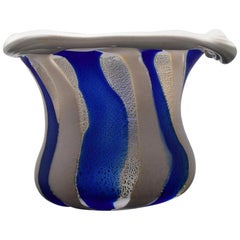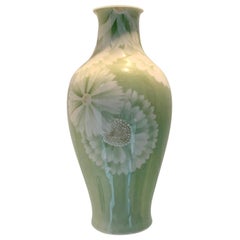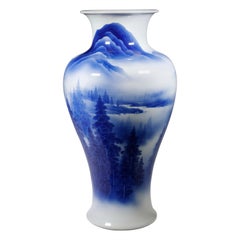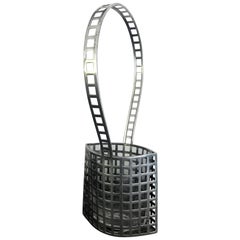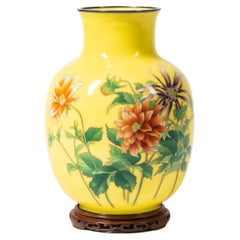TISHU Vases
to
1
91
10
11
17
63
10
25
7
26
5
2
1
1
3
1
4
4
35
1
1
90
6
5
5
5
101
63
63
49
24
24
Height
to
Width
to
101
101
101
15
7
4
4
3
Japanese Art Glass Sculptural Vessel by Kyohei Fujita
By Kyohei Fujita
Located in Atlanta, GA
A free standing glass sculpture in an open vessel form by Kyohei Fujita (1921-2004). The striking piece features an organic body with alternative strips of blue, white and transparent strips with gold sparkle inlays. The rim takes a free biomorphic form that resembles bone structure. It is etch signed underneath.
The vessel was made in the earlier period of the artist's career before he dedicated most of his work to the "magical box...
Category
Late 20th Century Japanese Mid-Century Modern Vases
Materials
Art Glass
Japanese Porcelain Vase Meiji Period Makuzu Kozan
By Makuzu Kozan
Located in Atlanta, GA
A finely decorated and glazed Japanese porcelain vase by Makuzu Kozan (1842-1916) circa 1900s Meiji Period. The vase is of a classic bottle form with baluster body and short neck. It was decorated with underglaze white magnolia blossom on a pleasant celadon background. The stamens of the flower were artistically rendered in a low relief, giving the design a realistic appeal with the dimension.
Miyagawa Kozan...
Category
Early 20th Century Japanese Meiji Ceramics
Materials
Porcelain
Rare and Large Japanese Porcelain Vase Makuzu Kozan
By Makuzu Kozan
Located in Atlanta, GA
A striking blue and white vase from the studio of Japanese Potter Makuzu Kozan, also known as Miyagawa Kozan (1842–1916), one of the most established and collected ceramist from Meiji Period. Born as Miyagawa Toranosuke, Kozan established his pottery studio in Yokohama around 1870s and later became one of the appointed artist to the Japanese Imperial household. His work was exhibited in many international fairs that the Meiji government participated at the turn of the century and won many grand prizes.
With an impressively large size, this vase was likely made and reserved as a presentation piece for one of the many expositions the studio participated in the early 20th century. It was decorated with underglaze cobalt blue using the novel technique developed by Kozan called Fuki-e (the blow painting), in order to achieve the striking dimensional literary landscape known as "Mountain and Water". Being one of the most creative ceramists, Kozan started experimenting with new chemical colors from the West in the format of his porcelain glaze around 1880s. New colors allowed him to create underglaze designs that appeared bright, smooth and glossy. He even invented his own receipt of cobalt blue to achieve a much brighter yet softer shade, as evident on this vase. To create landscape that is realistic and dimensional, more common in the western paintings, he was inspired by the native Japanese ink painting technique developed around 1900 by Yokoyama Taikan...
Category
Early 20th Century Japanese Japonisme Ceramics
Materials
Porcelain
Large Japanese Bamboo Ikebana Basket Maeda Chikubosai I
By Maeda Chikubosai
Located in Atlanta, GA
An important woven bamboo ikebana basket circa first half of the 20th century (Taisho or Showa era) by Japanese bamboo master Maeda Chikubosai I (1872-1950). Chikubosai I was from th...
Category
Early 20th Century Japanese Japonisme Vases
Materials
Bamboo
Rare Silver Vase with Glass Insert by Josef Hoffmann for Wiener Werkstätte
By Josef Hoffmann, Wiener Werkstätte
Located in Atlanta, GA
A Wiener Werkstatte silver reticulated flower basket with original glass insert in a very rare model made with silver. Designed by Josef Hoffmann (Austrian, 1870-1956), Vienna, circa...
Category
Early 20th Century Austrian Vienna Secession Sterling Silver
Materials
Silver
Japanese Cloisonné Vase Ando Jubei with Storage Box
By Ando Jubei
Located in Atlanta, GA
A beautifully decorated cloisonné vase with silver rims by Ando Jubei (1876-1956), the celebrated Japanese Shippo studio. The piece is dated to late Meiji to early Showa period circa...
Category
Early 20th Century Japanese Japonisme Metalwork
Materials
Metal, Silver, Enamel
Japanese Ceramic Vase by Ito Tozan I Meiji Period
By Ito Tozan I
Located in Atlanta, GA
This stoneware vase of a jar form was finely decorated with low relief carving and delicate colored glazes depicting bundles of peony flowers. It was made by Ito Tozan I (1846-1920) circa 1890-1900s in the late Meiji Period. The color pallet was both bold and subtle, with dark green and rusty leaves with golden outlines and white and light yellow peony petals covering much of the surface. Impressed with potter's mark on the base.
Examples of two pieces by Ito Tozan I were in the collection of MNAAG (Guimet) Paris. Inventory no. MG 13790 an 13792.
A vase with similar shape and decoration techniques is featured as Lot 1340 Fine Japanese Art, 13 Sep 2017 Bonhams New York
Tozan Ito I established his ceramic business in Kyoto 1867. His studio made both porcelain and stoneware in a style some considered Satsuma while they retained a sophistication of Kyoto ware...
Category
Antique 1890s Japanese Japonisme Ceramics
Materials
Ceramic
Asian Flambe Studio Pottery Vase
By Kyoto Pottery
Located in Atlanta, GA
A garlic bottle vase in an archaic Chinese form, but likely Japanese in origin. Several circumventing grooves however, suggest a more modern age. It was done in a brilliant purple glaze over a robin egg blue background glaze. The bubbling and bursting effects during the firing renders the surface an artistic spotting effect. The color pallet recalls the Classic Jun Yao...
Category
Antique Late 19th Century Japanese Japonisme Ceramics
Materials
Ceramic
Large Japanese Blue and White Vase by Mazuku Kozan Meiji Period
By Makuzu Kozan
Located in Atlanta, GA
A striking blue and white vase from the studio of Japanese Potter Makuzu Kozan, also known as Miyagawa Kozan (1842–1916), one of the most established and collected ceramist from Meiji Period. Born as Miyagawa Toranosuke, Kozan established his pottery studio in Yokohama around 1870s and later became one of the appointed artist to the Japanese Imperial household. His work was exhibited in many international fairs that the Meiji government participated at the turn of the century and won many grand prizes.
With a relative large size, this vase is decorated with underglaze cobalt blue using the novel technique developed by Kozan called Fuki-e (the blow painting), in order to achieve the striking dimensional misty winter landscape. The pine trees with upright trunks and down-sweeping branches appear receding into the depth of the mist, forming an visually unending forest. Known as one of the most creative ceramists, around 1880s, Kozan started experimenting with new chemical colors from the West in the format of his porcelain glaze. New colors allowed him to create underglaze design that appeared bright, smooth and glossy. He even invented his own receipt of cobalt blue to achieve a much brighter yet softer shade, as evident on this vase. To create landscape that is realistic and dimensional, more common in the western paintings, he was inspired by the native Japanese ink painting technique developed around 1900 by Yokoyama...
Category
Early 20th Century Japanese Japonisme Ceramics
Materials
Porcelain
Hagi Ikebana Vase by Kyusetsu Miwa X Japanese Studio Pottery
By Kyusetsu Miwa X
Located in Atlanta, GA
A stoneware vase with white dripping glaze from Hagi by Kyusetsu Miwa X (1895-1981), Showa Period. The vase is in the shape of "Double Gourd" with a bulbous ...
Category
20th Century Japanese Japonisme Ceramics
Materials
Ceramic
Early Japanese Satsuma Antique Vase
By Satsuma
Located in Atlanta, GA
An Satsuma ceramic stone ware vase, circa 19th century, around the end of the Edo and the beginning of Meiji period. In the form of a Classic garlic bottle whose prototype was from China, the white bodied piece is decorated with an early form of kin nishikide, the so called golden brocade, a palette of iron-red, blue, green, yellow, purple and black with golden highlight. The over glazed enamel paint shows a group of robed figures in a garden setting with a lion and three tigers. A transparent overall glaze shows very fine crackles. The design is relatively sparse with plenty of negative space in contrast to the Satsuma production from the late 19th century, when the trend became fussy and overly glitz, due to the influence by the perceived western taste for the export market. This piece may still be made for export but its pattern was more influenced by both Kyoto Pottery and the Kano school of painting compared to the export ware by the end of the 19th century onward to the early 20th century. It was believed by many that this was a result of Satsuma potters visiting Kyoto in the late seventeenth century to learn over glaze painting techniques.
There are some age glaze crackles especially around the foot. The piece is not signed in keeping with the earlier production before Satsuma ceramics...
Category
Antique Mid-19th Century Japanese Japonisme Ceramics
Materials
Ceramic
$2,850 Sale Price
25% Off
Japanese Ceramic Sake Bottle Chosen Karatsu Ware
Located in Atlanta, GA
The long neck bottle of classic form was heavily potted with coarse clay with high iron content. The flask, circa 18th century Edo period, was purposed for sake storage but also substituted as a flower vase during tea ceremony. The surface is covered in glossy black glaze and contrasts strikingly with white ash glaze around the shoulder. The white, fired with straw, displays a splashing feather effect and fine crackles, blending in with the black artistically. This type of Karatsu ware...
Category
Antique 18th Century Japanese Japonisme Ceramics
Materials
Ceramic
Rare Large Vase with White Slip Inlay Makuzu Kozan Meiji Period
By Makuzu Kozan
Located in Atlanta, GA
A impressively large and unusual stoneware vase in an urn shape from the studio of Japanese Potter Makuzu Kozan, also known as Miyagawa Kozan (1842–1916), one of the most established and collected ceramist from Meiji Period. Born as Miyagawa Toranosuke, Kozan established his pottery studio in Yokohama circa 1870s and later became one of the appointed artist to the Japanese Imperial household. His work was exhibited in many international fairs that the Meiji government participated at the turn of the century and won many grand prizes.
This vase is dated to the end of Makuzu's life circa 1910-1916 based on similar work created around that time. After achieving domestic and international fame, Makuzu retired and handed the business to his son Hanzan in 1912. He dedicated his time to other selected projects that were more in tune with Japanese sensibility than export aesthetic. He made a group of stoneware pottery pieces inspired by Edo master like Ninsei and Kenzan as well as his own poetic creation. This piece is attributed to that period.
Standing of an impressive size, this vase is more like an urn, made with stoneware instead of porcelain. It was coated with a brown iron glaze with a slight translucent quality. Underglaze whit slips were used to draw low relief decoration of bamboo leaves that sparsely scatter on the surface. Slightly more elaborate scrolling vines and autumn flowers circles under the mouth rim. Same white slip inlay was used to sign the vase under the base. The whole effect of the piece is unusual. With its dark glaze in contrast with the sparse white decoration that is more abstract and geometric than realistic, it appears almost modern with an Art Deco flavor.
For stoneware urn and vase in the similar genre by Makuzu Kozan: see figure 113 on page 182 of "Sekai ni Aisa Reta ya Kimono" MIYAGAWA KOZAN MAKUZU...
Category
Vintage 1910s Japanese Japonisme Ceramics
Materials
Ceramic
Vienna Secession Silvered Vase by Weiner Werkstatte
By Josef Hoffmann
Located in Atlanta, GA
A hammered silver plate metal vase attributed to Josef Hoffmann and made by Wiener Werkstatte, circa 1920s. The vase is in the typical style of the Vienna secession, it features a ve...
Category
Early 20th Century Austrian Vienna Secession Vases
Materials
Metal
Japanese Porcelain Dragon Glazed Vase Mazuku Kozan
By Makuzu Kozan
Located in Atlanta, GA
A porcelain vase with dragon motif by Japanese imperial potter Makuzu Kozan (1842-1916), circa 1900s. The vase is made in what is considered early phase of his underglaze period during late Meiji era. In a classic elongated baluster form, the surface of the vase was decorated in an unusual pink mist on a white and aubergine background (called Morotai, the Hazy style), on which a flying dragon is showcased on the center. The dragon was outlined in iron red and filled with the aubergine color and was artistically emphasized on its bulging eyes, claws, scales and a long tail. It was the sole focus of the design circumventing the entire body of the vase. The imagery calls in mind the dragon decoration found in Korean...
Category
Antique Early 1900s Japanese Japonisme Ceramics
Materials
Porcelain
Large Korean Blue and White Vase with Phoenix Design
Located in Atlanta, GA
A large and heavy Korean ceramic vase in a Classic Chinese form with open mouth with a wide flared rim, a neck with three concentric grooves and a sloped broad shoulder. The blue and white design features two underglazed phoenix...
Category
Early 20th Century Korean Archaistic Ceramics
Materials
Ceramic
Japanese Ceramic Vase Mingei Style Hamada Shoji
By Hamada Shoji
Located in Atlanta, GA
A heavily potted stoneware vase in cylindrical form, decorated with abstract strokes in iron rust glaze (known as Persimmon Glaze in Japanese) on a black glazed background. The pattern suggests autumn grasses, and it was applied with free hands. The vase is attributed to Japanese potter Hamada Shoji...
Category
Late 20th Century Japanese Arts and Crafts Ceramics
Materials
Ceramic
Japanese Mishima Ceramic Vase Meiji Period
Located in Atlanta, GA
A Japanese long neck slender ceramic vase in the style of Mishima, circa 19th century, Meiji period. Mishima pottery was originally imported from three islands in Taiwan and then fro...
Category
Antique 19th Century Japanese Japonisme Ceramics
Materials
Ceramic
Large Antique Chinese Sang-de-Boeuf LangYao Red Vase
Located in Atlanta, GA
A large Chinese vase with Sang-de-Boeuf (oxblood) glaze in a classic baluster form with a tall narrow neck and horizontal bands around the shoulder. The oxblood glaze is known as Lan...
Category
Antique Late 19th Century Chinese Chinese Export Ceramics
Materials
Ceramic
Korean Celadon Inlay Vase Goryeo Dynasty
Located in Atlanta, GA
On offer is an antique Korean ceramic vase from the end of Goryeo to the beginning of Joseon period (circa 14-15th). The vase features celadon crackled glaze with underglaze inlay design in black and white. The vase was a transitional piece made toward the end of Goryeo to the beginning of Joseon Yi dynasty...
Category
Antique 15th Century and Earlier Korean Archaistic Ceramics
Materials
Ceramic
Modern Studio Vase Bizen Ware by Jun Isezaki
Located in Atlanta, GA
A bottle form vase by Japanese studio ceramic artist Jun Isezaki (Born in 1936). A modern Bizen yaki stoneware piece that is strongly rooted in history and ...
Category
20th Century Japanese Organic Modern Ceramics
Materials
Ceramic, Wood
Large Antique White Glazed Bottle Vase Korean Ceramic Joseon Dynasty
Located in Atlanta, GA
On offer is a Korean ceramic bottle vase circa 19th century made in the late Joseon dynasty (1392-1910). The vase is of a classic bottle form with a bulbous body and a long neck with...
Category
Antique 19th Century Korean Other Ceramics
Materials
Ceramic
Ceramic Moon Jar Vase by Otto Heino
By Otto Heino
Located in Atlanta, GA
A ceramic vase in the form of a "moon jar", a nearly sphere shape with small base and mouth. The form was celebrated in Korean Joseon pottery and its fo...
Category
Early 2000s American Organic Modern Vases
Materials
Ceramic
$3,800 / item
Japanese Ceramic Ikebana Vase Bizen Ware Nanba Koyo
Located in Atlanta, GA
A tall vintage ceramic vase with handle from Japan (20th century) by Nanba Koyo. Made in the tradition of Bizen ware, the vase has a modern aesthetic with a...
Category
20th Century Japanese Japonisme Ceramics
Materials
Ceramic
$1,500 / item
Exquisite Japanese Satsuma Vase by Seikozan
Located in Atlanta, GA
A miniature vase in elegant upright form reminiscent of the Chinese imperial Willow Leaf form made by Japanese studio Seikozan circa 1890-1910s (late Meiji Period). One of the many a...
Category
Antique 1880s Japanese Meiji Ceramics
Materials
Ceramic
Sculptural Silver Center Bowl with Relief Surface Graziella Laffi
By Graziella Laffi
Located in Atlanta, GA
A stunning sterling silver vessel in the form of a stemmed bowl crafted by Graziella Laffi (1923-2009), Lima, Peru, Circa 1965. Marked on the rim: G. Laffi, PERU. The vessel was designed as a modern rendition of ancient pre-Columbina drinking vessel used in ceremony. The piece projects a regal and substantial aura due to its thick double wall construction with seamless craftmanship. The exterior surface was decorated with high relief roundels protrusion alternated with a radiating design that resembles star fish or a blooming flower. It has an impressive presence with its unique form and ornamentation that appears both modern and ancient at the same time.
Graziella Laffi was born in 1923 in Florence, Italy to Gino Laffi, a silversmith and artist. Following her family tradition, Graziella enrolled in master classes after elementary school, focusing on design and painting. She next attended Escuela de Bellas Artes de Puerta Romana for three years, where Gino taught, and then to the Accademia di Belle Arti di Firenze, where she concentrated in architecture until the start of World War II. In 1947, Graziella, then twenty-four, immigrated with her parents to Peru. Gino later created a silversmith studio and showroom called Fabrica Laffi on Avenue Mexico, where Graziella initially learned her Craft. The Pre-Columbian culture in her adopted country inspired Graziella to travel and collect, which ultimately influence her design in the silver pieces. Graziella learned the metalworking techniques of the ancient Peruvian civilizations and rejected the current technology. She mostly used hammering, rolling and creating joints as the ancients do. As an ambassador of Peruvian culture, her work promoted the indigenous Peruvian art and rekindled the interest in its ancient heritage throughout South America, the United States and Europe. She exhibited her growing collection of Peruvian artifacts...
Category
Vintage 1960s Peruvian Modern Sterling Silver
Materials
Sterling Silver
Antique Korean Buncheong Ceramic Vase with Incised Designs
Located in Atlanta, GA
A Korean ceramic bottle form jar of Buncheong ware circa 15-16th century Joseon Dynasty. The surface of the jar features a celadon glaze and an elaborate incised design of large flor...
Category
Antique 16th Century Korean Archaistic Ceramics
Materials
Ceramic
Antique Korean Celadon Bottle Vase Joseon Dynasty
Located in Atlanta, GA
A Korean ceramic bottle-form vase circa 16th century Joseon Dynasty. It was likely intended as a wine bottle, the pear-shaped vessel with flaring neck feature a celadon glaze exterio...
Category
Antique 16th Century Korean Archaistic Ceramics
Materials
Ceramic
Tall Studio Pottery Ceramic Glazed Vase Warren Mackinzie
By Warren MacKenzie
Located in Atlanta, GA
A tall cylinder shape stoneware vase by American studio potter Warren MacKenzie (1924-2018). The vase displays a slightly ambiguous shape between circle and sqaure and it features tw...
Category
Late 20th Century American Modern Vases
Materials
Ceramic
Ceramic Geometrical Vase with Black Metallic Glaze Beatrice Wood
By Beatrice Wood
Located in Atlanta, GA
A ceramic vase by American artist and studio potter Beatrice Wood (1893-1998). The piece, circa 1980s, is of a columnar form with a small bulged-out ring around midbody. Highly geome...
Category
Late 20th Century American Modern Vases
Materials
Ceramic
Studio Ceramic Vessel by Brother Thomas Bezanson
By Brother Thomas Bezanson
Located in Atlanta, GA
A ceramic vessel in the form of a footed bowl or chalice, studio crafted by Brother Thomas Bezanson (1929-2007) circa 1970s. Covered in a brill...
Category
Late 20th Century American American Craftsman Vases
Materials
Ceramic
Korean Caledon Vase Bottle with Kintsugi Repair Goryeo Dynasty
Located in Atlanta, GA
A ceramic wide-mouthed bottle vase covered in green celadon glaze from Goryeo dynasty circa 11-12th century. The bottle vase with such a form (mouth with wide rim, long and slender neck, tall body with swelled shoulders that taper down toward the base) is known as "kwanggubyong" in Korean and developed from the prototype of bottles from united Silla kingdom. It was used for holding oil or liquid. Some of this type of vase take a plain form without much decoration other than glaze; Some feature basic geometrical lines, such as this one. Three concentric rings were featured along the neck and on the shoulder. Some with more carving on the body (see a vase in the collection of Brooklyn Musuem, 79.246.3) or a simple paint with iron glaze (See c.16-1930 in Fitzwilliam Musuem, Cambridge, UK).
The vase on offer is covered in a lovely green celadon glaze which exhibits fine even crackles throughout the surface. It has a slightly uneven base with the foot ring shaved by the potter. The surface is original with a nice mellow patina. There is a historical kintsugi repair on the mouth rim, with its gold vain...
Category
Antique 15th Century and Earlier Korean Archaistic Ceramics
Materials
Ceramic
Pre-Columbian Cupisnique Stirrup Vessel from Peru
Located in Atlanta, GA
A pre-Columbian ceramic stirrup vessel in Cupisnique style circa 700-500BCE. This ancient vessel features a robust squatted body and a short thick stirr...
Category
Antique 15th Century and Earlier Peruvian Pre-Columbian Tribal Art
Materials
Ceramic
Ceramic Bowl with Expressive Glaze by Beatrice Wood
By Beatrice Wood
Located in Atlanta, GA
A ceramic bowl by American artist and studio potter Beatrice Wood (1893-1998). The elegant bowl has a deep half-hemisphere form that is supported by a sho...
Category
Late 20th Century American Modern Vases
Materials
Ceramic
Modern Japanese Studio Pottery Oribe Tea Pot by Ken Matsuzaki
By Ken Matsuzaki
Located in Atlanta, GA
A contemporary studio ceramic tea pot with metal handle made by Japanese potter Ken Matsuzaki (1950-). The stoneware tea pot showcases a thick dripping Oribe green glaze partially revealing the unglazed part of the body, which is decorated with scrolling pattern of ash glaze. The work is rooted in both Yohen Shino glaze technique and Oribe tradition, but interestingly it also paid homage to Sancai pottery...
Category
Early 2000s Japanese Modern Ceramics
Materials
Ceramic
Ceramic Vase Royal Doulton Chang Ware
By Royal Doulton
Located in Atlanta, GA
A glazed ceramic vase in slender spindle form from the Chang Ware series by Royal Doulton (England, founded 1815) circa 1920-30s. The vase was decorated with thick and dripping glaze in rich mottled polychrome colors. The glaze shows overall irregular crackles, a signature characteristic of Chang Ware. The base is hand-marked "NOKE", Royal Doulton in rectangle and initial HN (for Harry Nixon).
Developed by Charles J. Noke (1858-1941), Doulton's Art Director, as part of his experimentation into Chinese flambé glazes during the 1920s. Fired at very high temperatures, they were introduced commercially by Doulton in 1925 in response to popular demand for eastern style ceramics. They were applied primarily by Harry Nixon (1886-1955). The name Chang Ware was used by Doulton in reference to the possibly mythical Song potter, Chang the Elder, although it bears little relationship to Song ceramics.
Category
Vintage 1920s English Modern Vases
Materials
Ceramic
Collection of Four Chinese Ceramic Vases with Peachbloom Glaze
Located in Atlanta, GA
An American Midwest collection of four small Chinese ceramic vases covered in peach-bloom glaze circa Qing Dynasty, 19th century, possibly earlier. The set consists of three vases of...
Category
Antique 19th Century Chinese Qing Ceramics
Materials
Ceramic
Ceramic Vase with Green Glaze by John Ward
By John Ward
Located in Atlanta, GA
A stoneware vessel by British studio ceramist John Ward (1938-2023) circa 1985. The flat shouldered vase is molded in a simple and elegant form with harmonious proportion. A small mo...
Category
Vintage 1980s English Organic Modern Vases
Materials
Ceramic
Fine Japanese Ceramic Satsuma Vase by Kinkozan
By Kinkozan
Located in Atlanta, GA
A miniature Japanese ceramic vase from the end of Meiji period circa 1880s- 1910s by Kinkozan (1645-1927). One of the largest studio manufacturers of the export ceramics at the time ...
Category
Early 20th Century Japanese Meiji Ceramics
Materials
Ceramic
Korean Glazed Ceramic Vase Buncheong Ware Joseon Dynasty
Located in Atlanta, GA
A small antique Korean Buncheong stoneware vase from early Joseon Dynasty circa 16th century. The vase is of a classic pear form with a waisted neck, a flared mouth and a ringed base...
Category
Antique 16th Century Korean Other Ceramics
Materials
Ceramic
Japanese Porcelain Vase Makuzu Kozan Meiji Period
By Makuzu Kozan
Located in Atlanta, GA
A striking blue and white vase from the studio of Japanese Potter Makuzu Kozan, also known as Miyagawa Kozan (1842–1916), one of the most established and collected ceramist from Meiji Period. Born as Miyagawa Toranosuke, Kozan established his pottery studio in Yokohama circa 1870s and later became one of the appointed artists to the Japanese Imperial household. His work was exhibited in many international fairs that the Meiji government participated at the turn of the century and won many grand prizes.
Of a relatively large size, this vase is decorated with underglaze cobalt blue using the novel technique developed by Kozan called Fuki-e (the blow painting). As a result, the bamboos appear took on a three-dimensional quality as if appearing in a mist. Known as one of the most creative ceramists, circa 1887, Kozan started experimenting with new chemical colors from the West in the format of his porcelain glaze. New colors allowed him to create underglaze design that appeared bright, smooth and glossy. He even invented his own receipt of cobalt blue to achieve a much brighter yet softer shade, as evident on this vase. To create landscape that is realistic and dimensional, more common in the western paintings, he was inspired by the native Japanese ink painting technique developed around 1900 by Yokoyama Taikan...
Category
Antique Early 1900s Japanese Japonisme Ceramics
Materials
Ceramic
